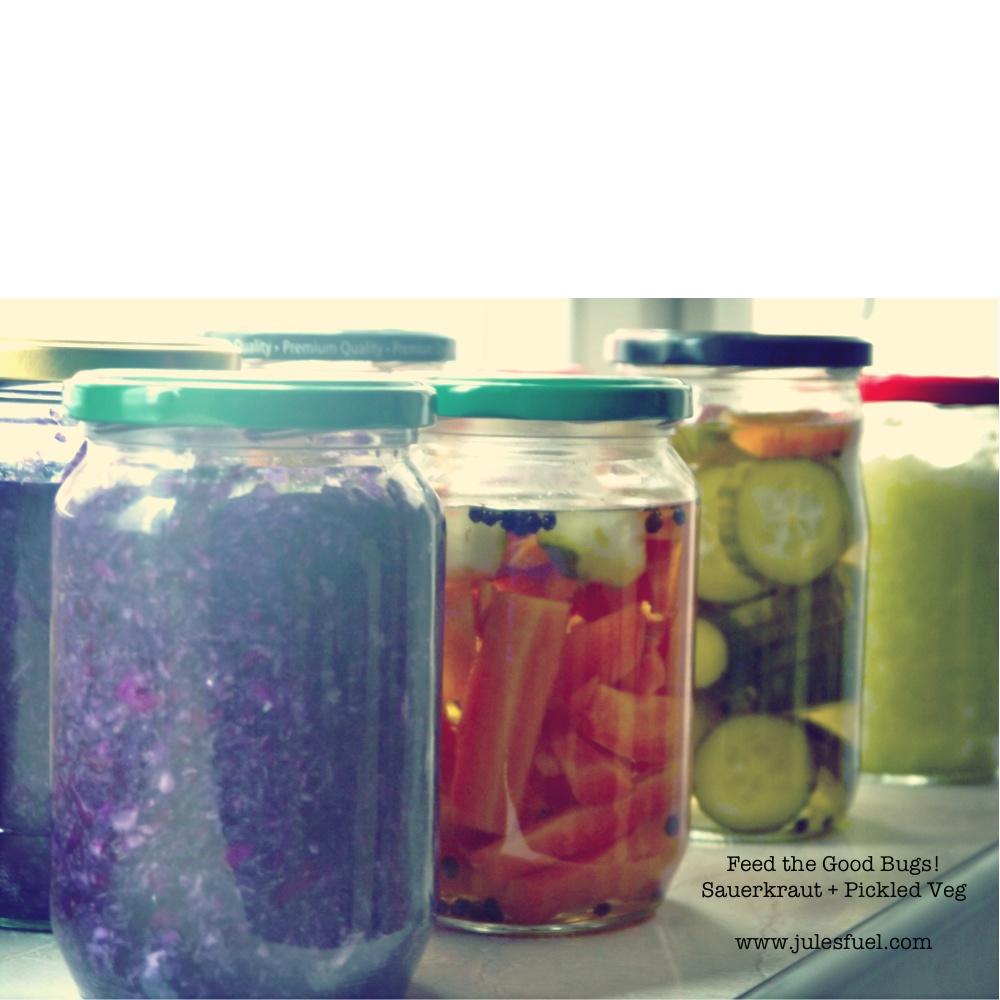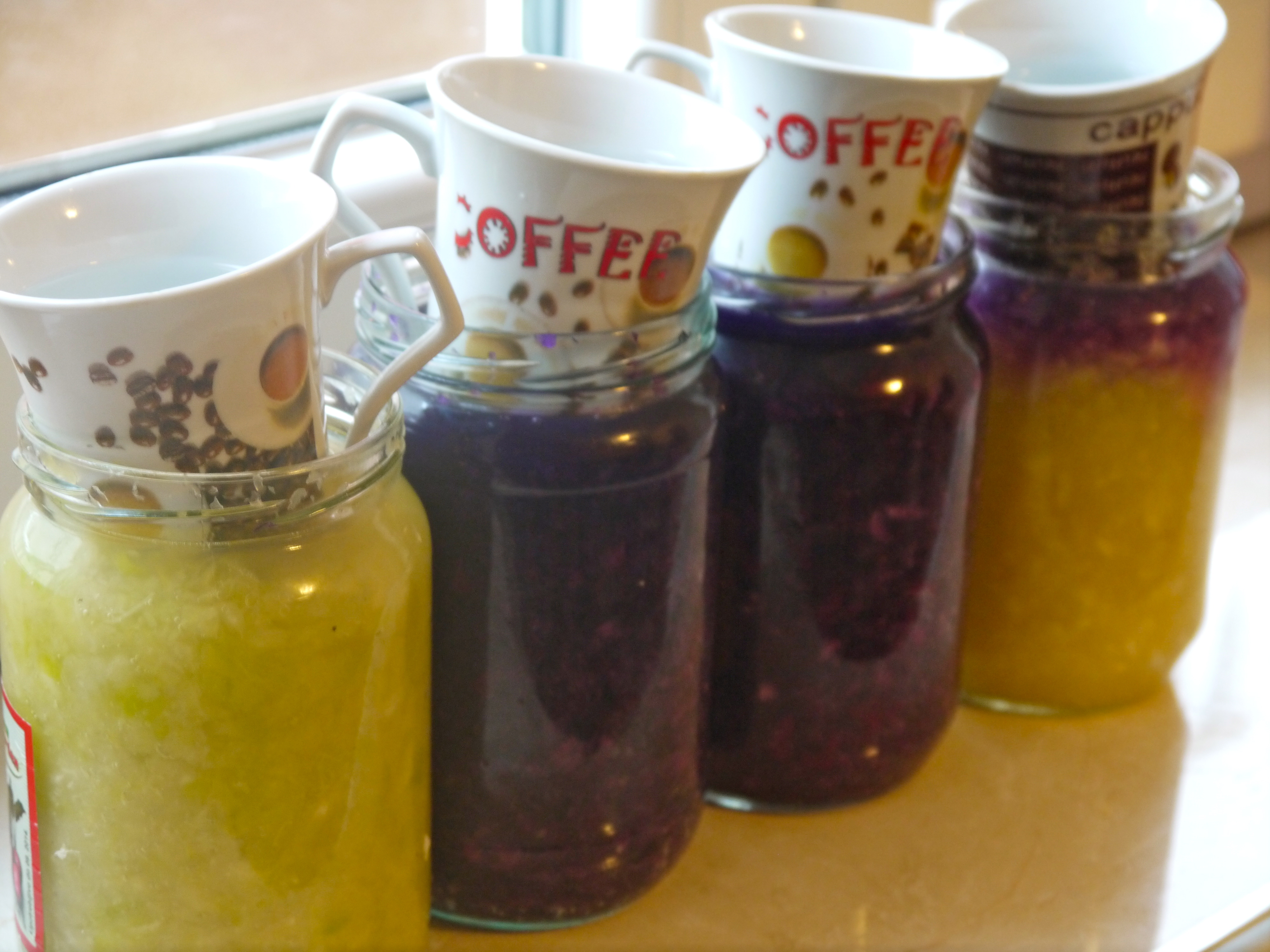My hands look like I killed something blue.
Who knew that purple cabbage could stain hands so much that it looks like I strangled a Smurf (remember Smurfs, anyone…)?
Inspired with the cabbage-heavy Serbian culture and a recent chapter from my class on the benefits of eating fermented foods, I was itching to do some experimentation in the kitchen.
I roped my friend, Wendy, into doing it with me, too, thinking we’d be done in no time.
Well, we got overzealous. With a HUGE green cabbage, medium purple cabbage, 4 carrots, 2 cucumbers, and 8 small onions to pickle, our 1 hour estimation to completion extended to 4 laborious hours.
Don’t worry.
There are shortcuts that I’ll share to make your efforts MUCH less time invasive.
A Fan of Fermentation
With fermentation on my mind, we started first with making sauerkraut, followed by pickled carrots, pickled cucumbers and pickled onions.
Is your nose crinkling?
It shouldn’t.
Fermented food, which transforms into food with good, living bacteria after just a few days, was an ancient staple in ALL cultures for not only food preservation and easier digestion, but as daily necessities for survival.
And with our fast-paced, preservative-loving, processed food culture, we’ve eliminated this food group almost entirely, and we’re suffering because of it.
Fermented foods, like sauerkraut or pickled vegetables (or yoghurt – not the fruity kind, but the real kind – cheese, pickles, bread, beer, wine, kefir, kombucha, etc.), are loaded with probiotics to help feed our good bacteria, and ward off the bad.
You see, we are literally comprised of BILLIONS of bacteria. You could even say that we’re the host of our bacteria, because it far outweighs even the quantity of our DNA! (For more info, read The Economist’s “Microbes Maketh the Man.“)
“The average human colon contains over 800 species of microbiota and at least 7000 different strands. 60 percent of the fecal matter you produce consists of microbial bodies.” – Dr. Cate Shanahan, Deep Nutrition
Don’t get grossed out on me. We NEED this good bacteria to populate our guts in order to:
- Fight off bad bugs
- Break down toxins
- Secrete hormones (which includes helping ahem, elimination…)
- Produce vitamins and short-chain fatty acids in our colon
- Help us maintain homeostasis
Modern living including consuming bad food (high in inflammatory oils, sugar and preservatives), antibiotics, alcohol, coffee, and stress can all contribute to this off-kiltered balance in our gut bacteria, promoting the bad bugs and toxins to reign.
Enter inflammation and disease…
So, I highly encourage you to open up your mind and your taste buds to fermented foods on a daily basis (it doesn’t have to be much!) to restore and/or promote thriving health.
Though I happen to adore the taste of sauerkraut and pickled vegetables, even if I didn’t, I would eat these types of fermented foods on a regular basis because they are that crucial for health.
With dozens of recipe varieties and variations, I twisted simpler versions for our sauerkraut and pickled veg, as inspired from Sally Fallon’s Nourishing Traditions Cookbook.
Homemade Sauerkraut Recipe
Ingredients
1 large green cabbage (or purple cabbage)
2 tbsp of sea salt
3ish large mason jars (depending on size of cabbage)
Instructions
1. Use a knife to chop the cabbage finely. Or, better yet, use a grater to shred the cabbage (works better in the long run!). Still better yet, shred the cabbage finely in a food processor.
2. Transfer the cabbage mixture (keep the juice!!) to a large bowl(s).
3. Use a heavy object (like a hammer or edge of a rolling pin) to beat the cabbage for a few minutes until the cabbage releases more juices.
4. Add the sea salt, and use your hands to mix evenly amongst the cabbage mixture.
5. Transfer the cabbage to mason jars, and continue pressing the cabbage down until it is submerged in its juices.
6. Use a small weight to place inside the jars, in order to keep the cabbage submerged under the juices, such as a smaller mason jar.
7. Cover with a light towel or cloth for 3 – 7 days (depending on preference for taste), until fragrant without being stinky. If there is enough brine above the cabbage, put the lid on tightly.
8. Seal the jars and store in your refrigerator, where they will last several weeks! Enjoy with salads, meat, or whatever tickles your fancy!
::Homemade Pickled Vegetables::
Ingredients
2 large carrots
1 cucumber
1 large onion
1 – 2 liters of vinegar
2 tbsp sea salt
1 – 2 tbsp of black peppercorns
Optional: Other seasonings to taste (i.e. red pepper flakes, herbs, etc.)
2ish large mason jars (depending on amount of veg)
Instructions
1. Slice carrots, cucumbers, and onions into thin strips of preference (rounds or vertical sticks).
2. Place in jars, either separate or mixed together.
3. Add about 1 tbsp of salt and 1 tbsp of black peppercorns in each jar (along with optional seasonings.)
4. Fill each jar with white vinegar until it covers the vegetables.
5. Secure the lid tightly, and allow 3 – 5 days for fermentation to occur.
6. Transfer to your refrigerator, where they will last several weeks!
:::
Now, if only these 3 days would go by quickly so I can munch on some ‘kraut with Serbian cevapi…
Happy Fermenting to you and yours!
References
Shanahan, Catherine & Luke Shanahan. Deep Nutrition. Lawai, Hawaii: Big Box Books, 2009.












